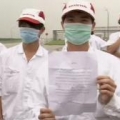Creative China: Counter-Mapping the Creative Industries
I just learned (h/t dr.woooo) about this bilingual special issue of the Chinese journal Urban China (城市中国), edited by Mónica Carriço, Bert de Muynck and Ned Rossiter, and published in November 2008. The issue was part of a project organized by cultural theorist Rossiter called Organized Networks: Mobile Research Labs, Beijing. The journal issue seems hard to find (you could try to order copies here), but most of the contents are here, and you can see some of the illustrated pages here. I’ve copied the table of contents below, with links to the articles.
This issue of Urban China sets out to critique and redefine the idea and practice of ‘mapping’ the creative industries. Foregrounding the experimental process of collaborative constitution, we are interested in the multiple idioms of expression that make creative industries intelligible beyond the blandness of policy discourse. Activist researchers, artists and writers in Europe, Brazil and India have been particularly inventive in combining collaborative techniques of production with social-political critique via media of communication. We see this work as part of the prehistory and global dialogue around how to create new spaces and transdisciplinary knowledges able to negotiate the complexities and politics that attend the economization of culture.
Contents
Prologue: Creative China (extract)
Jiang Jun and Kuang XiaomingNetwork of Contributors
Creative Industries Timeline
Introduction: Counter-Mapping Creative Industries in Beijing
Ned RossiterCollusion and Collision of Cities within Cities
Shveta SardaSection 1: Network Ecologies of Creative Waste (Introduction)
Soenke ZehleCreative Industries or Wasteful Ones?
Richard Maxwell and Toby MillerNetwork Ecologies: Documenting Depletion, Exhausting Exposure
Soenke ZehleSection 2: Information Geographies vs. Creative Clusters (Introduction)
Ned RossiterEvery Morning and One Day
Ni WeifengCan You Manufacture a Creative Cluster?
Danny ButtCreative Clusters: Out of Nowhere?
Michael KeaneDemographics, Scale and Business Models for Chinese Internet Companies
Piet WalravenHoles in the Net? State Rescaling, Creative Control and the Dispersion of Power
Xuefei RenFrida V. in Beijing and OpenStreetMap’s First Leaps in Beijing
Luka FrelihOrgNets + OpenStreetMap Presents: Beijing Bicycle Tour
UmiSection 3: Migrant Networks and Service Labour (Introduction)
Brett NeilsonLabour, Migration, Creative Industries, Risk
Brett NeilsonMigrant Workers, Collaborative Research and Spatial Pressures: An Interview with Meng Yue
Ned Rossiter and Meng YueInverting the Cultural Map: Peripheral Geographies of Beijing’s Creative Production
Adrian BlackwellSection 4: Centrality of Real-Estate Speculation for Creative Economies (Introduction)
Ned RossiterCultural Heritage Map of Beijing
Carla Nayton / Beijing Cultural Heritage Protection Center (CHP)Constructing The Real (E)state of Chinese Contemporary Art: Reflections on 798, in 2004
Thomas J. BerghuisSection 5: Import Cultures / Export Innovations in Architecture and Urban Design (Introduction)
Bert de MuynckHow Foreign Architects became International Architects: A Case Study of China’s Creative Construction Agenda
Bert de MuynckAn Architecture of Mediation
David BrownMapping Architectural Practice in Beijing
北京地区建筑设计实践纵览
Hao Dong and Binke Lenhardt / crossboundaries
董灏和蓝冰可Moving Towards a Creative Society
Shaun ChangSection 6: Artist Villages and Market Engineering (Introduction)
Bert de MuynckThe Art of Keys: Profit and Loss in the Art Village Industry
Adrian Hornsby and Neville MarsOther Kinds of Ambitions: From Artist Villages to Art Districts
Alexander PasternackBORDERLINE Moving Images 2007
Beatrice Leanza / BorderlineHomeShop Series Number One: Games 2008 Off the Map
Elaine Wing-ah Ho / HomeShopBeijing’s Art Districts: From Creative Hubs to Entertainment Centres
Manuela LiettiDetours and Developments in Beijing’s Music Scene
Leo de BoisgissonThe Uncertain Aesthetics of Contemporary Chinese Visual Culture
Paul GladstonIs there Really Space for Creativity?
Lothar Spree and Davide QuadrioSection 7: Policy
Creative China, Managerial Innovation, Global Brands: An Interview with John Howkins
Urban China and John HowkinsCreative Industries with Chinese Characteristics: An Interview with Professor Zhang Jingcheng
Urban China and Zhang JingchengSection 8: Creative Portraits



 "Revolutionaries are
"Revolutionaries are
Leave a Reply